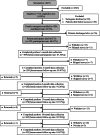Associations Between Family-Assessed Quality-of-Dying-and-Death Latent Classes and Bereavement Outcomes for Family Surrogates of ICU Decedents
- PMID: 38299933
- PMCID: PMC11093430
- DOI: 10.1097/CCM.0000000000006199
Associations Between Family-Assessed Quality-of-Dying-and-Death Latent Classes and Bereavement Outcomes for Family Surrogates of ICU Decedents
Abstract
Objectives: To examine associations between family surrogates' bereavement outcomes and four previously determined quality of dying and death (QODD) latent classes (high, moderate, poor-to-uncertain, and worst).
Design: Prospective, longitudinal, observational study.
Setting: Medical ICUs at two academically affiliated medical centers in Taiwan.
Patients/participants: Three hundred nine family surrogates responsible for decision-making for critically ill patients at high risk of death (Acute Physiology and Chronic Health Evaluation II scores > 20) from a disease.
Interventions: None.
Measurements and main results: Participants were assessed by the depression and anxiety subscales of the Hospital Anxiety and Depression Scale, the Impact of Event Scale-Revised, 11 items of the Prolonged Grief Disorder (PGD) scale, and the Medical Outcomes Study 36-Item Short-Form Health Survey at 1, 3, 6, 13, 18, and 24 months post-loss. We simultaneously examined associations of four QODD latent classes with physical and mental health-related quality of life (HRQOL) and symptoms of anxiety, depression, post-traumatic stress disorder (PTSD), and PGD assessed over 24 bereavement months using multivariate hierarchical linear modeling. Surrogates' distinct QODD latent classes assessed at 1-month post-loss were significantly associated with bereavement outcomes, except for physical HRQOL and PGD symptoms. Significantly more depressive symptoms and worse mental HRQOL (β [95% CI]) were reported by bereaved surrogates in the moderate (1.958 [1.144-2.772], -2.245 [-3.961 to -0.529]), poor-to-uncertain (2.224 [1.438-3.010], -7.026 [-8.683 to -5.369]), and worst (2.081 [1.215-2.964], -4.268 [-6.096 to -2.440]) QODD classes than those in the high QODD class. Bereaved surrogates in the moderate (2.095 [1.392-2.798]) and poor-to-uncertain (0.801 [0.123-1.480]) QODD classes reported more anxiety symptoms, whereas those in the poor-to-uncertain QODD class suffered more PTSD symptoms (2.889 [1.005-4.774]) than those in the high QODD class.
Conclusions: The four distinct QODD latent classes were significantly associated with ICU family surrogates' bereavement outcomes, suggesting targets to improve end-of-life care quality in ICUs.
Copyright © 2024 The Author(s). Published by Wolters Kluwer Health, Inc. on behalf of the Society of Critical Care Medicine and Wolters Kluwer Health, Inc.
Conflict of interest statement
The authors have disclosed that they do not have any potential conflicts of interest.
Comment in
-
ICU Family Bereavement: Demonstrating Predictors and a Call to Improve Outcomes.Crit Care Med. 2024 Jun 1;52(6):982-984. doi: 10.1097/CCM.0000000000006280. Epub 2024 May 16. Crit Care Med. 2024. PMID: 38752816 No abstract available.
References
-
- Hartog CS, Maia PA, Ricou B, et al. : Changes in communication of end-of-life decisions in European ICUs from 1999 to 2016 (Ethicus-2)—a prospective observational study. J Crit Care. 2022; 68:83–88 - PubMed
-
- Sprung CL, Truog RD, Curtis JR, et al. : Seeking worldwide professional consensus on the principles of end-of-life care for the critically ill. The Consensus for Worldwide End-of-Life Practice for Patients in Intensive Care Units (WELPICUS) study. Am J Respir Crit Care Med. 2014; 190:855–866 - PubMed
-
- Davidson JE, Aslakson RA, Long AC, et al. : Guidelines for family-centered care in the neonatal, pediatric, and adult ICU. Crit Care Med. 2017; 45:103–128 - PubMed
-
- Zimmerman JJ, Harmon LA, Smithburger PL, et al. : Choosing wisely for critical care: The next five. Crit Care Med. 2021; 49:472–481 - PubMed
Publication types
MeSH terms
LinkOut - more resources
Full Text Sources
Medical
Miscellaneous


